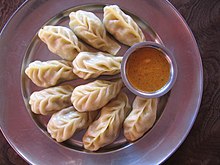Momo (food)


Momo (Tibetan: མོག་མོག་, Wylie: mog mog,Nepali:म:म:, is a type of dumpling native to Himalayas of Tibet. It is similar to Mongolian buuz, Chinese jiaozi, or Central Asian manti, closely related to Russian pelmeni, German Maultaschen or Italian ravioli.
The Tibetan word Momo is a loanword from the Chinese mómo (馍馍).[1]
Making momo

Momos are made with a simple flour-and-water dough—white flour is generally preferred—and sometimes a little yeast or baking soda is added to give a more 'doughy' texture to the finished product. The filling may be one of several mixtures described below:
- Meat: different kinds of meat filling are popular in different regions. In Tibet, Nepal and North Eastern India, goat, buffalo, chicken, yak meat, and pork are the most popular, while in Ladakh, India lamb and yak are common, while in other Indian cities (e.g., Guwahati), pork and chicken would be the most popular meats used in momos. Minced meat is combined with any or all of the following: onions, shallots, garlic, and cilantro/coriander. The mixture is spiced with salt, pepper, and often ground cumin. Some people also add finely puréed tomatoes, and many variations are possible.
- Vegetarian or mixed momos are becoming increasingly popular in India and Nepal.
- Potato, similar to Indian samosas, with small dice of firm potato in a tomato based sauce.
- Cheese, usually a fresh cheese, this variety is common in Bhutan and Sikkim.
- Snickers or Mars Bar, an original sweet momo sold mostly in areas of Nepal that are popular with foreign tourists[2][3].
The dough is fashioned into small circular flat pieces. The filling is then enclosed either in a round pocket or in a half moon shape or crescent. The dumplings are then cooked by steaming over a soup (either a stock based on bones or tomato-based), which is served with the dumplings, as well as chili sauce. The dumplings may also be pan-fried or deep-fried after being steamed. They are often accompanied by an Indian pickle achar.
History
Momos are a traditional delicacy in Tibet, Bhutan, Sikkim, Nepal, and Ladakh. They are one the most popular fast food in those regions. They are also common in places with noticeable Tibetan diaspora, such as Assam, Mizoram,Manipur, Nagaland, Meghalaya, Himachal Pradesh, and West Bengal (particularly in Darjeeling ). Over the last decade momos have become a very popular street food in many Nepalese cities such as Kathmandu, Pokhara, Dharan and Indian cities, such as Guwahati,Kolkata, Siliguri, Delhi and Chandigarh. In Nepal, Chicken, Buff i.e.Buffalo, Vegetarian, Mutton, Pork, Paneer Momo are made.
Varieties
There are different varieties of momos. Most common are C-momo, Kothey momo, Momo soup and Fried momo. C-momo is regular momo dipped in a hot and spicy sauce consisting of onions, capsicums, etc., and usually served in a bowl. Fried momos are prepared by deep frying the steamed momos. Momo soup is steamed momos immersed in a meat broth and Kothey momos are pan-fried. These are some of the most common items served in Tibetan and Nepalese restaurants.
Price of Momos
A plate of momo would cost you not more than Rs 15 in towns like Darjeeling, Gangtok, Siliguri. In Cities like Bangalore, it will actually cost you Rs 45 for a plate of beef momo and at some few places they might charge you around Rs 50 i.e for a chicken momo.
